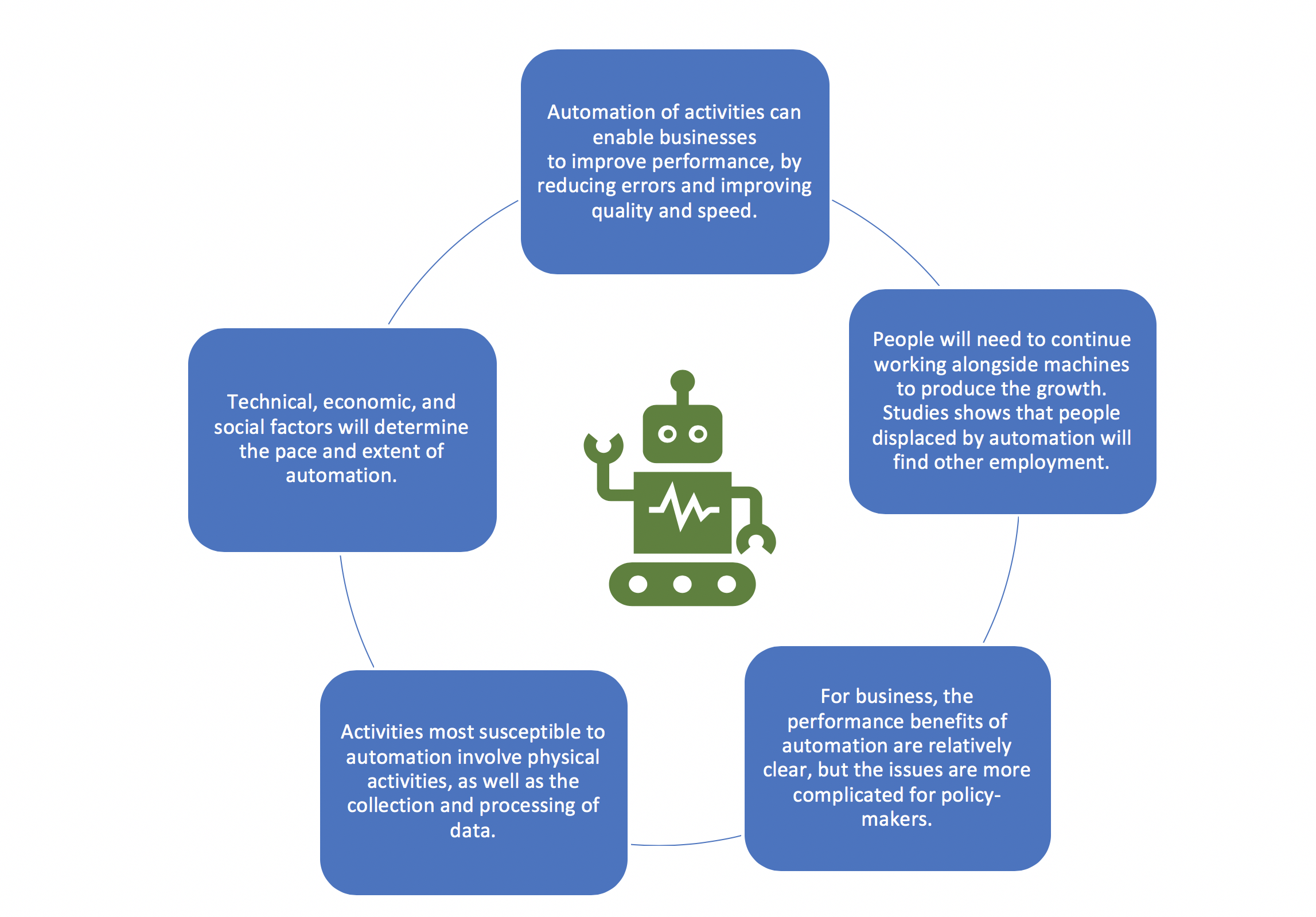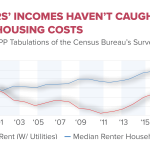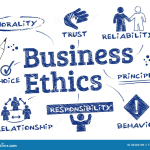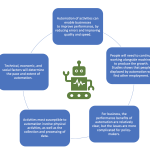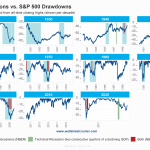The ongoing AI labor market changes are shaping the future of work in profound ways, presenting both opportunities and challenges for today’s workforce. As researchers analyze trends in labor market dynamics, technological disruption emerges as a dominant theme, with workforce automation significantly transforming job roles and expectations. A recent study highlights the phenomenon of occupational churn, indicating not just stability but a shift driven by AI advancements that cannot be ignored. With the dramatic rise of AI job impact, the implications extend beyond mere job displacement—businesses are rapidly evolving, adapting to new demands for skills and technological proficiency. Thus, employees across all sectors must brace for the repercussions of these shifts and rethink their career strategies to navigate the complexities ahead.
The transformation of the labor landscape through artificial intelligence is becoming increasingly evident, as the integration of computer-driven labor solutions is redefining traditional employment models. This metamorphosis suggests a critical examination of workforce automation and its ripple effects across various industries, driving substantial occupational turnover and altering job requirements. As organizations embrace these emerging technologies, the discussion around the future of work grows ever more pertinent, emphasizing the need for adaptability among professionals. With the evolution of roles influenced by AI advancements, businesses must cultivate an environment where continuous learning and flexibility are prioritized. Ultimately, understanding the nuances of these shifts will be essential for navigating the work environment of tomorrow.
Understanding Occupational Churn Amid AI Disruption
Occupational churn refers to the ongoing transformation within the labor market as professions rise and fall in prominence. According to a recent study co-authored by renowned economists David Deming and Lawrence H. Summers, AI is emerging as a pivotal force reshaping occupational dynamics. The study spans over a century, offering a historical lens through which we can understand how technological disruptions have historically influenced job availability. Notably, the findings reveal a downtime between 1990 and 2017, challenging the notion that technology, particularly AI, has been an unequivocal job thief.
However, as we moved into 2019, signs of turbulence became evident, indicating that the AI labor market changes were starting to take effect. This newfound volatility hinted at a shift towards an economy favoring highly skilled, well-compensated jobs — a departure from the previous trends of job polarization that had favored low-paid, unskilled positions. By analyzing occupational churn through the lens of AI impacts, it becomes clear that we are not only in the midst of a transformation but also that such changes may accelerate as AI continues to evolve.
The Rise of STEM Jobs in a Technology-Driven Economy
In recent years, the demand for STEM (Science, Technology, Engineering, and Mathematics) jobs has experienced a significant resurgence, according to the research findings by Deming and Summers. Following a previously observed decline in the 2010s, the share of STEM-related occupations rose from 6.5% to nearly 10% between 2010 and 2024. This surge reflects the labor market’s increasing reliance on advanced skills, emphasizing the importance of workforce automation as companies anticipate the future of work. With technology becoming an integral part of various industries, the pursuit of technical expertise has never been more critical.
The growing emphasis on STEM occupations signals a fundamental shift in workforce dynamics. Companies are not just hiring more technical talent but are also investing heavily in cutting-edge technologies like AI. This trend indicates a clear acknowledgment of the critical role such technologies play in driving productivity and innovation. As businesses navigate through a landscape transformed by AI, we can expect a persistent rise in demand for highly trained professionals who can harness these advancements effectively.
AI’s Role in Job Displacement and Creation
With the rapid growth of AI, concerns about job displacement continue to loom large over the workforce. Deming’s research highlights that while some sectors may face severe job losses, particularly in low-paid service roles, the evolution of AI also leads to the creation of new positions requiring different skill sets. Jobs in sectors like food service or health care are returning but in altered forms that necessitate enhanced technical capabilities. This churning signifies not just losses but a transformation in job types, as employers seek workers adept at managing and integrating automation into their workflows.
Moreover, while AI promises to enhance productivity in various sectors, it raises questions about the long-term sustainability of jobs that cannot adapt to new technological realities. As illustrated by examples such as retail, where a decline in sales jobs correlates with the rise of e-commerce driven by predictive AI, the labor market must be agile and responsive to these changes. Ultimately, understanding the dual role of AI as both a disruptor and a creator of opportunities will be essential for navigating this evolving landscape.
Impact of Automation Anxiety on Workforce Dynamics
The term ‘automation anxiety’ captures the trepidation many workers feel about the encroachment of machines and AI into traditional job roles. Deming’s analysis indicates that this anxiety peaked in the 2000s when predictions suggested an alarming percentage of jobs were at risk of automation. However, the research illuminates a significant shift, marking a period of low occupational churn that could ease the fears associated with labor market changes. Understanding the fluctuations in employment share across various industries helps contextualize the experience of workers caught in the tides of change.
As we examine the ongoing transformation, it is essential to address workforce anxiety. With the advent of more competent AI systems, knowledge workers in sectors like finance and journalism are expected to adapt quickly. This environment has led professionals to re-evaluate their value and skill sets, recognizing that staying relevant will require continuous learning and adaptation to emerging technologies. Ultimately, bridging the gap between innovation and workforce apprehension is vital for fostering a resilient labor market.
Four Trends Shaping the Post-Pandemic Job Market
The paper by Deming and Summers identifies four key trends currently reshaping the job market, underscoring AI’s profound influence on employment dynamics. One notable trend is the significant growth in high-paying jobs that demand advanced skills, marking a pivotal shift from previous job polarization trends. As businesses adjust to an increasingly automated economy, roles traditionally seen as secure are evolving in response to this technological disruption. As organizations emphasize efficiency and talent acquisition, there will be a greater demand for skilled professionals who can navigate the complexities of a tech-enhanced workplace.
Another critical trend is the decline of low-wage jobs, particularly in service sectors heavily impacted by the pandemic. The research indicates a stark reduction in retail sales positions fueled by the rise of e-commerce platforms leveraging AI. This represents not just a reaction to specific economic pressures, such as the COVID-19 pandemic, but also a long-term realignment of market demands. As more consumers embrace the convenience of online shopping, the future of work will likely require an adaptation of labor strategies, favoring roles that incorporate technological innovations.
Navigating the Future of Work and AI Integration
The evolving role of AI presents both challenges and opportunities for the workforce of the future. As technology integrates more deeply into daily operations, professionals across various sectors must adapt to new ways of working that emphasize collaboration with AI tools. This integration requires a shift in mindset as organizations begin to realize that AI can enhance employee productivity rather than simply replace jobs. The challenge lies in ensuring that workers are equipped with the skills necessary to thrive within this new framework.
By fostering a culture of ongoing education and training, businesses can mitigate the risks associated with automation while optimizing the benefits of AI. As we look to the future of work, collaboration between human ingenuity and artificial intelligence will be paramount. Rash decisions to resist or reject this partnership may lead to missed opportunities for growth and improvement across industries. Embracing AI as an ally rather than a foe will ultimately shape the trajectory of labor market evolution.
Understanding the Evolving Landscape of Retail Jobs
The retail sector has witnessed profound transformations in recent years, a trend closely tied to advances in technology and AI. The findings of Deming and Summers indicate that the share of retail sales jobs has significantly declined, dropping from 7.5% to 5.7% within just ten years. This reduction can be attributed to several factors, particularly the rapid rise of e-commerce, which leverages predictive AI to enhance customer experiences and streamline operations. As consumers adapt to new shopping behaviors, traditional retail roles are reassessing their function in an increasingly digital marketplace.
The pandemic acted as a catalyst for these changes, accelerating a shift that was already underway. With many consumers turning to online shopping for safety, businesses have had to adapt quickly, leading to new habits in consumer behavior. Consequently, the focus is shifting to roles that encompass digital competency alongside customer engagement skills, which are critical for addressing the modern retail landscape. Businesses must now strategize around these evolutions as they work to recruit and retain talent that can navigate this transformed environment.
The Importance of Continuous Learning in a Tech-Driven Job Market
In a labor market increasingly influenced by AI and automation, continuous learning emerges as a vital necessity for employees. The research emphasizes that professionals must engage in lifelong learning to keep pace with rapid technological advancements. The ability to adapt quickly will serve as a key differentiator in a job landscape where new tools and practices are regularly introduced. Companies are likely to seek workers who demonstrate a willingness to learn and adapt, ensuring they remain relevant amid evolving technological paradigms.
Moreover, as AI continues to reshape job roles and expectations, fostering a culture of continuous education will become imperative for organizations seeking to enhance productivity and innovation. Training programs focused on technical skills, data literacy, and AI collaboration will empower employees to leverage technology effectively in their roles. By investing in their workforce’s education, companies can create more resilient teams that not only adapt to change but excel in the face of it.
Reimagining Job Roles Amid Technological Evolution
As artificial intelligence and advanced technologies continue to reshape the labor landscape, job roles must be reimagined to reflect the new reality of work. Employers are increasingly looking to develop positions that combine human skills with advanced technological capabilities, thus marrying the need for interpersonal competencies with technical proficiency. This shift signifies an evolution in how we define job success and the skills necessary to achieve it. With a focus on collaboration with AI, workers will need to acquire the knowledge to make technology work for them.
This reimagining of roles suggests a future where jobs are not simply displaced but transformed into opportunities for enhanced creativity, problem solving, and innovation. By adopting new organizational structures centered around technology integration, businesses can better navigate the uncertainties posed by automation. The key will be fostering resilience and adaptability in workers, encouraging them to embrace the changes AI brings while contributing their unique human touch to an increasingly tech-driven world.
Frequently Asked Questions
What are the significant AI labor market changes impacting job security today?
AI labor market changes are reshaping job security through significant ‘occupational churn,’ where traditional roles are evolving or becoming obsolete. Notably, the rise of automation has led to job displacement in low-paid service sectors while creating demand for high-skill roles in science, technology, engineering, and mathematics (STEM). This transformation suggests that workers need to adapt to new technologies to remain competitive.
How does workforce automation affect the future of work in the U.S.?
Workforce automation, a result of AI advancements, is driving the future of work towards higher-skilled positions while decreasing opportunities in lower-paid jobs. This shift indicates a ‘barbell pattern’ in job availability, with growth in high-wage roles requiring advanced training, while many traditional roles face decline. Continuous adaptation and upskilling will be key for workers navigating the evolving labor market.
What are the trends indicating occupational churn due to AI job impact?
Recent research indicates several trends driven by AI job impact, such as increased growth in highly compensated STEM positions, a trend towards the decline of retail sales jobs, and reduced service work opportunities. As automation continues, these patterns highlight an urgent need for workers to embrace skill development in tech-related fields to stay relevant.
Why is AI considered a breakthrough technology in workforce automation?
AI is viewed as a breakthrough technology because it significantly alters job structures, similar to past technologies like keyboards and electricity. Its capability to enhance productivity while simultaneously automating tasks positions it at the forefront of workforce automation trends, necessitating a fundamental shift in how we approach work and skills in various sectors.
What insights can be drawn from historical data on technological disruption and AI labor market changes?
Historical data on technological disruption reveals that while prior periods exhibited low occupational churn, recent AI labor market changes indicate a substantial increase in job volatility. This suggests that ongoing technological evolution will likely continue to drive substantial changes in employment patterns, reinforcing the importance of adaptability among workers.
How can workers prepare for the changes in the AI labor market?
To prepare for changes in the AI labor market, workers should focus on continuous learning and skill development, particularly in areas linked to technology and data analysis. Embracing adaptable learning strategies and seeking roles that leverage AI tools can enhance job security and open new career opportunities as workforce automation reshapes the landscape.
What sectors are experiencing the greatest decline due to AI and automation?
The sectors experiencing significant decline due to AI and automation include retail and low-paid service industries. For example, retail jobs have seen a dramatic reduction as e-commerce and AI-driven technologies reshape consumer habits, emphasizing the need for retail employees to transition into roles that support the digitized market.
What role does ‘automation anxiety’ play in understanding AI’s impact on the labor market?
‘Automation anxiety’ reflects the concern among workers about job security as AI technologies evolve. This psychological aspect of AI labor market changes highlights the fear of displacement while also underscoring the need for proactive adaptation to technological advancements, ensuring that workers can leverage AI rather than be replaced by it.
What is the significance of AI in shaping the distribution of jobs in the economy?
AI significantly shapes job distribution by driving demand for specialized skill sets and altering traditional employment patterns. As companies invest in AI technologies, they prioritize hiring for high-skill positions while automating routine tasks, leading to a more polarized job market that favors experienced workers and diminishes opportunities for roles that require less expertise.
| Trend | Description |
|---|---|
| Job Polarization | Shift from a barbell pattern in labor market to a one-sided pattern favoring skilled, high-compensated roles. |
| Surge in STEM Jobs | Increase in STEM positions from 6.5% in 2010 to nearly 10% in 2024. |
| Decline in Low-Paid Service Jobs | Flat or declining growth in low-paid service roles since 2019. |
| Retail Sales Job Reductions | 25% decrease in retail sales jobs from 2013 to 2023 due to e-commerce shifts. |
Summary
AI labor market changes are becoming increasingly prominent as technology continues to disrupt traditional job structures. As demonstrated by recent studies, particularly the work of economists David Deming and Lawrence H. Summers, there are significant shifts in occupational patterns, emphasizing a rise in high-skill jobs and a notable decline in low-wage service positions. The findings indicate that while the labor market experienced stability in past decades, AI is now reshaping the landscape, focusing attention on the increasing importance of STEM fields and the declining prevalence of retail jobs. This evolution in the workforce necessitates an understanding of how AI influences not just job availability, but also the skill requirements for future employment.
